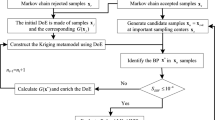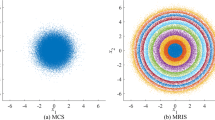Abstract
Uncertainty of quantitative models of input variables and computational model could certainly cause the uncertainties of structural response and structural reliability. Hence, structural reliability analysis requires precise input uncertainty model and highly accurate solving model. However, not all uncertain input variable can be described by an explicit quantitative model in practical engineering. Generally, only incomplete samples of some variables are available in practice. Though Monte Carlo Simulation (MCS) has been used to solve above problem, we are confronted with another trouble due to the expensive two-layer MCSs. Furthermore, approximate methods for reliability assessment would cause confidence problem of reliability. To handle with the challenges, an adaptive kriging (AK) model-based approach is proposed by dividing the two-layer MCSs into two AK models. Simultaneously, a new quantitative model for interval variables is developed to deal with input uncertainty. And a novel learning function improved by H learning function (IH function) is developed with a weight function to enhance the efficiency of constructing kriging models. The IH function not only considers design sites with large uncertainty, but also actively searches for that around the LSF by assigning different weight value for design points. In the proposed approach, the first AK model is constructed for reliability prediction. And the relationship between parameters of input models and reliability is built by the other kriging model using the first one. Credibility assessment will be implemented according to the second model. Since, only the first AK model needs the time-consuming finite element (FE) calculations, the proposed approach could significantly improve the efficiency of confidential reliability analysis without losing accuracy. Several numerical examples are implemented to demonstrate the feasibility and effectiveness of the proposed model.














Similar content being viewed by others
References
Apostolakis G (1990) The concept of probability in safety assessments of technological systems. Science 250(4986):1359–1364
Ben-Haim Y, Elishakoff I (1990) Convex models of uncertainty in applied mechanics. Elsevier, Amsterdam
Bichon BJ, Eldred MS, Swiler LP, Mahadevan S, McFarland JM (2008) Efficient global reliability analysis for nonlinear implicit performance functions. AIAA J 46(10):2459–2468
Campi MC, Calafiore G, Garatti S (2009) Interval predictor models: identification and reliability. Automatica 45(2):382–392
Chen Z, Li G, He J, Yang Z, Wang J (2022) A new parallel adaptive structural reliability analysis method based on importance sampling and K-medoids clustering. Reliab Eng Syst Saf 218:108124
Cho H, Choi KK, Gaul NJ, Lee I, Lamb D, Gorsich D (2016) Conservative reliability-based design optimization method with insufficient input data. Struct Multidisc Optim 54(6):1609–1630
Cox DD, John S (1992) A statistical method for global optimization. In: Proceedings of 1992 IEEE international conference on systems, man, and cybernetics, 1992. IEEE, pp 1241–1246
Echard B, Gayton N, Lemaire M (2011) AK-MCS: an active learning reliability method combining Kriging and Monte Carlo simulation. Struct Saf 33(2):145–154
Elishakoff I, Elisseeff P, Glegg SA (1994) Nonprobabilistic, convex-theoretic modeling of scatter in material properties. AIAA J 32(4):843–849
Gayton N, Bourinet JM, Lemaire M (2003) CQ2RS: a new statistical approach to the response surface method for reliability analysis. Struct Saf 25(1):99–121
Gelman A, Carlin JB, Stern HS, Rubin DB (1995) Bayesian data analysis. Chapman and Hall/CRC, Boca Raton
Gunawan S, Papalambros PY (2006) A Bayesian approach to reliability-based optimization with incomplete information. J Mech Des (ASME) 128(4):909–918
Harney HL (2016) Bayesian inference: data evaluation and decisions. Springer, Heidelberg
Jones DR, Schonlau M, Welch WJ (1998) Efficient global optimization of expensive black-box functions. J Glob Optim 13(4):455–492
Jung Y, Lee I, Cho H (2019) Reliability measure approach for confidence-based design optimization under insufficient input data. Struct Multidisc Optim 60(5):1967–1982
Jung Y, Kang K, Cho H, Lee I (2021) Confidence-based design optimization (CBDO) for a more conservative optimum under surrogate model uncertainty caused by Gaussian Process. J Mech Des (ASME) 143(9):1–35
Kawaguchi K, Kaelbling LP, Lozano-Pérez T (2015) Bayesian optimization with exponential convergence. In: Advances in neural information processing systems, 2015, vol 28
Kennedy MC, O’Hagan A (2001) Bayesian calibration of computer models. J R Stat Soc B 63(3):425–464
Li M, Wang Z (2019) Surrogate model uncertainty quantification for reliability-based design optimization. Reliab Eng Syst Saf 192:106432
Li X, Gong C, Gu L, Gao W, Jing Z, Su H (2018) A sequential surrogate method for reliability analysis based on radial basis function. Struct Saf 73:42–53
Long T, Wei Z, Shi R, Wu YF (2021) Parallel adaptive kriging method with constraint aggregation for expensive black-box optimization problems. AIAA J 59(9):3465–3479
Lv Z, Lu Z, Wang P (2015) A new learning function for Kriging and its applications to solve reliability problems in engineering. Comput Math Appl 70(5):1182–1197
Martz HF, Waller R (1982) Bayesian reliability analysis. Wiley, New York
Meng Z, Zhang Z, Li G, Zhang D (2020) An active weight learning method for efficient reliability assessment with small failure probability. Struct Multidisc Optim 61(3):1157–1170
Moon MY, Choi KK, Cho H, Gaul N, Lamb D, Gorsich D (2017) Reliability-based design optimization using confidence-based model validation for insufficient experimental data. J Mech Des (ASME) 139(3):031404
Moon MY, Choi KK, Cho H, Gaul N, Lamb D, Gorsich D (2018) Confidence-based reliability assessment considering limited numbers of both input and output test data. Struct Multidisc Optim 57(5):2027–2043
Moon MY, Choi KK, Gaul N, Lamb D (2019) Treating epistemic uncertainty using bootstrapping selection of input distribution model for confidence-based reliability assessment. J Mech Des (ASME) 141(3):031402
Morgan MG, Henrion M, Small M (1990) Uncertainty: a guide to dealing with uncertainty in quantitative risk and policy analysis. Cambridge University Press, Cambridge
Noh Y, Choi KK, Lee I (2010) Identification of marginal and joint CDFs using Bayesian method for RBDO. Struct Multidisc Optim 40(1):35–51
Noh Y, Choi KK, Lee I (2011) Reliability-based design optimization with confidence level under input model uncertainty due to limited test data. Struct Multidisc Optim 43(4):443–458
Parry GW (1996) The characterization of uncertainty in probabilistic risk assessments of complex systems. Reliab Eng Syst Saf 54(2–3):119–126
Qiu Z, Wang X (2003) Comparison of dynamic response of structures with uncertain-but-bounded parameters using non-probabilistic interval analysis method and probabilistic approach. Int J Solids Struct 40(20):5423–5439
Wang C, Matthies HG (2019) Novel model calibration method via non-probabilistic interval characterization and Bayesian theory. Reliab Eng Syst Saf 183:84–92
Wang X, Qiu Z, Elishakoff I (2008) Non-probabilistic set-theoretic model for structural safety measure. Acta Mech 198(1):51–64
Wang C, Matthies HG, Xu M, Li Y (2018) Epistemic uncertainty-based model validation via interval propagation and parameter calibration. Comput Methods Appl Mech Eng 342:161–176
Wang Y, Hao P, Yang H, Wang B, Gao Q (2020) A confidence-based reliability optimization with single loop strategy and second-order reliability method. Comput Methods Appl Mech Eng 372:113436
Wu J, Jiang Z, Song H, Wan L, Huang F (2021) Parallel efficient global optimization method: a novel approach for time-dependent reliability analysis and applications. Expert Syst Appl 184:115494
Xue G, Dai H, Zhang H, Wang W (2017) A new unbiased metamodel method for efficient reliability analysis. Struct Saf 67:1–10
Yang X, Liu Y, Gao Y, Zhang Y, Gao Z (2015) An active learning kriging model for hybrid reliability analysis with both random and interval variables. Struct Multidisc Optim 51(5):1003–1016
Youn BD, Wang P (2008) Bayesian reliability-based design optimization using eigenvector dimension reduction (EDR) method. Struct Multidisc Optim 36(2):107–123
Zhang R, Mahadevan S (2000) Model uncertainty and Bayesian updating in reliability-based inspection. Struct Saf 22(2):145–160
Zhang X, Wang L, Sørensen JD (2019) REIF: a novel active-learning function toward adaptive Kriging surrogate models for structural reliability analysis. Reliab Eng Syst Saf 185:440–454
Funding
This study was supported by National Nature Science Foundation of the P. R. China (No. 12002014), the Fundamental Research Funds for the Central Universities, National Nature Science Foundation of the P. R. China (Nos. 52192632 and 12132001), Beijing Advanced Discipline Center for Unmanned Aircraft System, Beijing Municipal Science and Technology Commission (No. Z191100004619006), Defense Industrial Technology Development Program (Nos. JCKY2018601B001 and JCKY2019203A003).
Author information
Authors and Affiliations
Corresponding author
Ethics declarations
Conflict of interest
The authors declare that they have no conflict of interest.
Ethical approval
This article does not contain any studies with human participants or animals performed by any of the authors.
Replication of results
The MATLAB codes of the examples are available in the Supplementary Materials. And the DACE package can be found in http://www2.imm.dtu.dk/pubdb/pubs/1460-full.html.
Additional information
Responsible Editor: Christian Gogu
Publisher's Note
Springer Nature remains neutral with regard to jurisdictional claims in published maps and institutional affiliations.
Electronic supplementary material
Below is the link to the electronic supplementary material.
Appendix
Appendix
According to Eqs. (4) and (5), the posterior joint PDF of the two parameters can be solved as
where constant \(\lambda\) is
Thus, the marginal PDFs is shown as
Rights and permissions
Springer Nature or its licensor (e.g. a society or other partner) holds exclusive rights to this article under a publishing agreement with the author(s) or other rightsholder(s); author self-archiving of the accepted manuscript version of this article is solely governed by the terms of such publishing agreement and applicable law.
About this article
Cite this article
Wu, P., Li, Y. Adaptive kriging model-based structural reliability analysis under interval uncertainty with incomplete data. Struct Multidisc Optim 66, 22 (2023). https://doi.org/10.1007/s00158-022-03474-9
Received:
Revised:
Accepted:
Published:
DOI: https://doi.org/10.1007/s00158-022-03474-9




